
EN 14470-1 - EN 14470-2 safety cabinets

GENERAL
For obvious safety reasons, flammable and/or explosive products, or gas cylinders, should be stored in safety cabinets. Whatever your field of activity, whether you are storing low-flammability or extremely flammable products, or low-flammability or extremely flammable gases, these must be stored safely to delay the risk of fire-related explosions.
STANDARDISATION
 EN 14470-1 : This standard, which came into force in October 2004 and will be amended in 2023, concerns the storage of flammable products. It applies to cabinets with an internal volume of 2 m3 or less.
EN 14470-1 : This standard, which came into force in October 2004 and will be amended in 2023, concerns the storage of flammable products. It applies to cabinets with an internal volume of 2 m3 or less.
 EN 14470-2 : This standard, which came into force in April 2006, concerns the storage of compressed gas cylinders in laboratories. It applies to cabinets with a total internal volume capable of storing gas cylinders with a total capacity of less than 220 litres.
EN 14470-2 : This standard, which came into force in April 2006, concerns the storage of compressed gas cylinders in laboratories. It applies to cabinets with a total internal volume capable of storing gas cylinders with a total capacity of less than 220 litres.
 FM 6050 (FACTORY MUTUAL) : International insurance and accreditation body for fire protection equipment (through UL) and advice for companies. FM 6050 approval means 10 minutes fire resistance for safety cabinets according to the NFPA 251-1969 temperature curve.
FM 6050 (FACTORY MUTUAL) : International insurance and accreditation body for fire protection equipment (through UL) and advice for companies. FM 6050 approval means 10 minutes fire resistance for safety cabinets according to the NFPA 251-1969 temperature curve.
 NF EN 16121+A1 : This standard specifies the requirements for determining the safety, strength, durability and stability of all types of storage furniture for collective use.
NF EN 16121+A1 : This standard specifies the requirements for determining the safety, strength, durability and stability of all types of storage furniture for collective use.
MAIN REQUIREMENTS
1. Fire protection : In the event of a fire, the cabinet must guarantee that, for at least 30 minutes, its contents will not contribute to increasing the risk or spreading the fire. 3 classes have been defined by the standard to enable users to choose the enclosure best suited to their needs and the level of risk assessed.
2. Fire tests: The cabinets presented in this part of the catalogue have undergone a fire destruction test in accordance with standard EN 14470-1 or standard EN 14470-2. These tests were carried out by an external laboratory accredited by COFRAC.
3. Retention volume (EN 14470-1 only) : The volume of the retention tank must be able to hold at least 110% of the volume of the largest container stored in the cabinet or 10% of the total volume stored.
4. Construction: The enclosure doors must be self-closing in any position (EN 14470-1 only). The various walls of the enclosure must be of identical construction and of the same thickness. The standard also covers the construction of the enclosure itself and its ability to withstand external fire conditions (fire tests carried out in accordance with ISO 834-1 and EN 1363-1).
5. Signage: The cabinets must be fitted with appropriate signage: standardised pictograms in accordance with ISO 3864 :
- EN 14470-1: flammable materials, no naked flames and no smoking, maximum load per shelf, capacity of the largest container that can be introduced into the cabinet, fire resistance of the model (30, 60 or 90 minutes), doors kept closed when the cabinet is not in use.
- EN 14470-2: presence of compressed gas cylinders, fire resistance of the model (30, 60 or 90 minutes), doors kept closed when the cabinet is not in use.
6. Ventilation: Cabinets must be fitted with air inlet and outlet orifices which close automatically in the event of fire, enabling them to be connected to a forced ventilation system. For a ventilated cabinet, air renewal must be at least equal to 10 times the volume of the cabinet per hour (120 times in the case of storage of toxic gas cylinders), with the door(s) closed.
CHOOSE YOUR CABINET ACCORDING TO YOUR SECTOR OF ACTIVITY AND THE FLAMMABILITY LEVEL OF YOUR PRODUCTS:
(1) PE (flash point): minimum temperature at which, under specified test conditions, a liquid emits sufficient gas to ignite momentarily in the presence of an ignition source.
(2) Please refer to the section of the catalogue concerning our safety cabinets for flammable and explosive products.
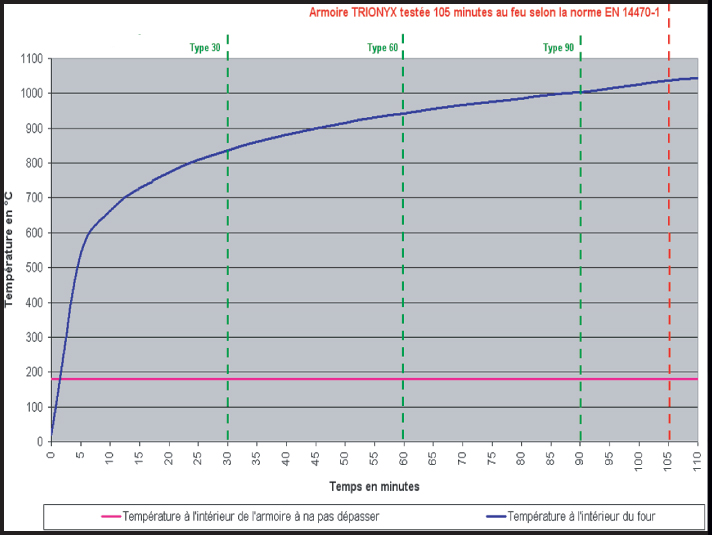

-
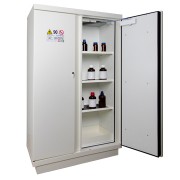
90 minutes flammable resistant security cabinets for flammables - on board transportation and maritime motions -
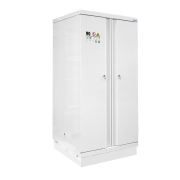
Fire resistant cabinets 90 min - for drums -
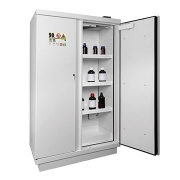
Fire resistant cabinets - EN 14470-1 - automatic inventory management -

EN 14470-1 safety cabinets Type 90 - for flammables -
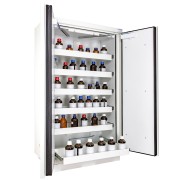
EN 14470-1 safety cabinets Type 90 - for flammables - with drawers -
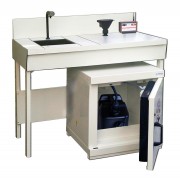
EN 14470-1 safety cabinets Type 90 - for waste recovery -

EN 14470-1 safety cabinets Type 30 - for flammables -
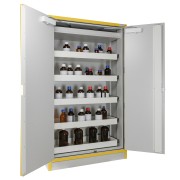
EN 14470-1 safety cabinets Type 30 - for flammables - with drawers -
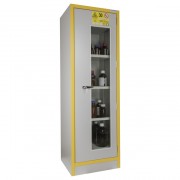
EN 14470-1 safety cabinets Type 30 - for flammables - with glass doors -
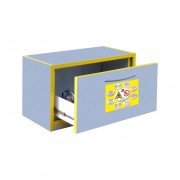
EN 14470-1 safety cabinets Type 30 - for flammables - under-bench -
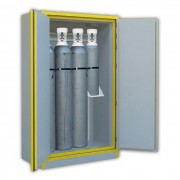
EN 14470-2 safety cabinets Type 30 - for gas cylinders